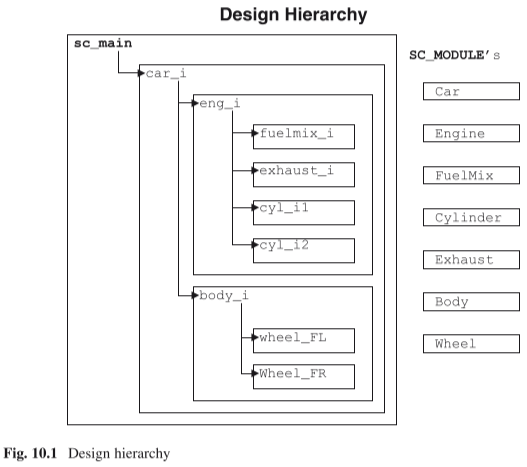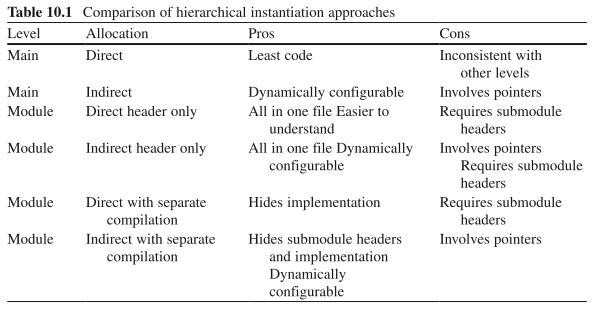[Emulate] Structure Design Hierarchy
Structure Design Hierarchy1

Module Hierarchy
C++ offers two basic ways to create submodule objects within the definition of a parent module or object. First, a submodule object may be created directly by declaration just like any simple member data of the module class. Second, a submodule object may be indirectly referenced by means of a pointer in combination with dynamic allocation.

- Direct top-level (
sc_main) - Indirect top-level (
sc_main) - Direct submodule header-only
- Direct submodule
- Indirect submodule header-only
- Indirect submodule
Direct Top-Level Implementation
//FILE: main.cpp
#include <systemc>
#include "Car.h"
int sc_main(int argc, char* argv[]) {
Car car_i("car_i");
sc_start();
return 0;
}
Indirect Top-Level Implementation
It adds the possibility of dynamically configuring the design with the addition of if-else and looping constructs.
//FILE: main.cpp
#include <systemc>
#include "Car.h"
intsc_main(int argc, char* argv[]) {
Car* car_iptr;
// pointer to Car
car_iptr = new Car("car_i");
// create Car
sc_start();
delete car_iptr;
return 0;
}
Direct Submodule Header-Only Implementation
//FILE:Car.h
#include "Body.h"
#include "Engine.h"
SC_MODULE(Car) {
Body body_i;
Engine eng_i ;
SC_CTOR(Car)
: body_i("body_i") //initialization
, eng_i("eng_i") {
// other initialization
}
};
Direct Submodule Implementation
//FILE:Car.h
#include "Body.h"
#include "Engine.h"
SC_MODULE(Car) {
Body body_i;
Engine eng_i;
Car(sc_module_name nm);
};
//FILE:Car.cpp
#include <systemc>
#include "Car.h" // Constructor
SC_HAS_PROCESS(Car);
Car::Car(sc_module_name nm)
: sc_module(nm)
, body_i("body_i")
, eng_i("eng_i") {
// other initialization
}
Indirect Submodule Header-Only Implementation
//FILE:Body.h
#include "Wheel.h"
SC_MODULE(Body) {
Wheel* wheel_FL_iptr;
Wheel* wheel_FR_iptr;
SC_CTOR(Body) {
wheel_FL_iptr = new Wheel("wheel_FL_i");
wheel_FR_iptr = new Wheel("wheel_FR_i");
// other initialization
}
};
Indirect Submodule Implementation
Moving the module indirect approach into the implementation file has the advantage of possibly supplying pre-compiled object files making this approach good for IP distribution.
This advantage is in addition to the possibility of dynamically determining the configuration discussed previously.
This approach is good for both internal and external IP distribution.
//FILE:Engine.h
class FuelMix;
class Exhaust;
class Cylinder;
SC_MODULE(Engine) {
FuelMix* fuelmix_iptr;
Exhaust* exhaust_iptr;
Cylinder* cyl1_iptr;
Cylinder* cyl2_iptr;
Engine(sc_module_name nm); // Constructor
};
//FILE: Engine.cpp
#include <systemc>
#include "FuelMix.h"
#include "Exhaust.h"
#include "Cylinder.h"
// Constructor
SC_HAS_PROCESS(Engine);
Engine::Engine(sc_module_name nm)
: sc_module(nm)
{
fuelmix_iptr = new FuelMix("fuelmix_i");
exhaust_iptr = new Exhaust("exhaust_i");
cyl1_iptr = new Cylinder("cyl1_i");
cyl2_iptr = new Cylinder("cyl2_i");
// other initialization
}
-
D. C. Black, J. Donovan, B. Bunton, and A. Keist, SystemC: From the Ground Up, Second Edition, 2nd ed. Springer US, 2010. ↩